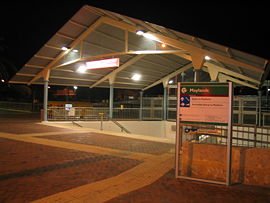Maylands, Western Australia
|
Maylands Perth, Western Australia |
|||||||||||||
|---|---|---|---|---|---|---|---|---|---|---|---|---|---|

Maylands railway station
|
|||||||||||||
| Coordinates | 31°55′52″S 115°53′56″E / 31.931°S 115.899°ECoordinates: 31°55′52″S 115°53′56″E / 31.931°S 115.899°E | ||||||||||||
| Population | 12,353 (2011 census) | ||||||||||||
| • Density | 2,470/km2 (6,400/sq mi) | ||||||||||||
| Established | 1830s | ||||||||||||
| Postcode(s) | 6051 | ||||||||||||
| Area | 5 km2 (1.9 sq mi) | ||||||||||||
| Location | 5 km (3 mi) NE of Perth | ||||||||||||
| LGA(s) | City of Bayswater | ||||||||||||
| State electorate(s) | Maylands | ||||||||||||
| Federal Division(s) | Perth | ||||||||||||
|
|||||||||||||
Maylands is a riverside suburb approximately 4.5 kilometres (2.8 mi) northeast of Perth centred on the Midland railway line on the northern bank of the Swan River.
The suburb was developed during the 1890s and is an administrative locality within the City of Bayswater (having been mostly within the City of Stirling until 1998), bordered by the suburbs of Mount Lawley, East Perth and Bayswater. Maylands railway station provides easy access to the City centre and beyond. The railway line was originally built in the 1880s, and the railway station was extensively refurbished in 2000. Recently a shared bicycle / pedestrian path was built to link Maylands with neighbouring suburbs via the shoreline of the Swan River. There is also a small yacht club and a golf course.
Maylands was once a source of clay for brick and tile making, and the pits from these activities are now part of a golf course and residential area. It was home to Perth's main airport which serviced all kinds of aircraft and even flying boats until the early 1960s, when the airport moved to Perth Airport. The facilities were then converted to a training area for the Western Australian Police Service.
In December 2009, the City of Bayswater endorsed the Maylands Activity Centre Urban Design Framework following widespread community consultation. The Urban Design Framework provides the strategic direction for the future of the Maylands town centre. This document has been instrumental in guiding the ongoing revitalisation of the Maylands town centre.
Over recent years, Maylands' revitalisation has gathered significant momentum, with a variety of new developments and businesses bringing new residents and vibrancy to the town centre. New bars, cafés and restaurants, along with gourmet food and retail outlets have all contributed to an ongoing transformation of the Maylands town centre into a lively, diverse and inclusive destination.
Maylands continues to evolve as a cultural and creative hub, with the relocation of the Western Australian Ballet to the former Western Australian Institute for the Blind building on Whatley Crescent in 2012. Estudio Nuevo, Studio 281, Swallow Bar and the Maylands Hawkers Markets each provide a variety of music, performance, dance, artistic, cultural and culinary experiences that exemplify Maylands' unique creative and community flavour.
...
Wikipedia

